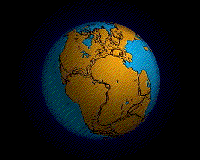There were many things to learn about the world (maps were actually only the last third of the book) and for example I blame my fascination for scuba diving on this book. Also last year, when we visited the Mont-Doré in Auvergne and I had to explain how volcanos are formed to my kids to make them forget how many stairs were still ahead of them to the summit, I did that while mentally picturing the pages in that book about plate tectonics.
But there is one thing I about tectonics that has been bothering me for a long time and I still haven't found a good explanation for (or at least an acknowledgement that there is something to explain): Since the days of Alfred Wegener we know that the jigsaw puzzle pieces of the continents fit in a way that geologists believe that some hundred million years ago they were all connected as a supercontinent Pangea.

By Original upload by en:User:Tbower - USGS animation A08, Public Domain, Link
In fact, that was only the last in a series of supercontinents, that keep forming and breaking up in the "supercontinent cycle".

By SimplisticReps - Own work, CC BY-SA 4.0, Link
So here is the question: I am happy with the idea of several (say $N$) plates roughly containing a continent each that a floating around on the magma driven by all kinds of convection processes in the liquid part of the earth. They are moving around in a pattern that looks to me to be pretty chaotic (in the non-technical sense) and of course for random motion you would expect that from time to time two of those collide and then maybe stick for a while.
Then it would be possible that also a third plate collides with the two but that would be a coincidence (like two random lines typically intersect but if you have three lines they would typically intersect in pairs but typically not in a triple intersection). But to form a supercontinent, you need all $N$ plates to miraculously collide at the same time. This order-$N$ process seems to be highly unlikely when random let alone the fact that it seems to repeat. So this motion cannot be random (yes, Sabine, this is a naturalness argument). This needs an explanation.
So, why, every few hundred million years, do all the land masses of the earth assemble on side of the earth?
One explanation could for example be that during those tines, the center of mass of the earth is not in the symmetry center so the water of the oceans flow to one side of the earth and reveals the seabed on the opposite side of the earth. Then you would have essentially one big island. But this seems not to be the case as the continents (those parts that are above sea-level) appear to be stable on much longer time scales. It is not that the seabed comes up on one side and the land on the other goes under water but the land masses actually move around to meet on one side.
I have already asked this question whenever I ran into people with a geosciences education but it is still open (and I have to admit that in a non-zero number of cases I failed to even make the question clear that an $N$-body collision needs an explanation). But I am sure, you my readers know the answer or even better can come up with one.





